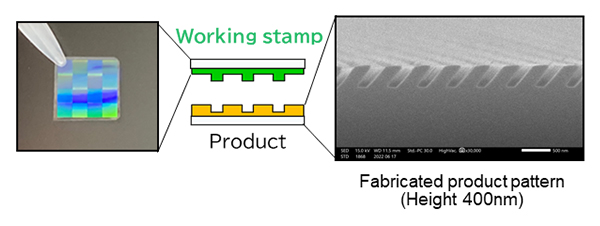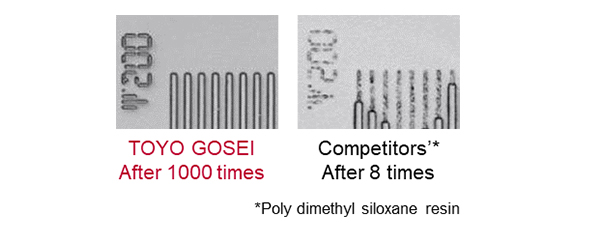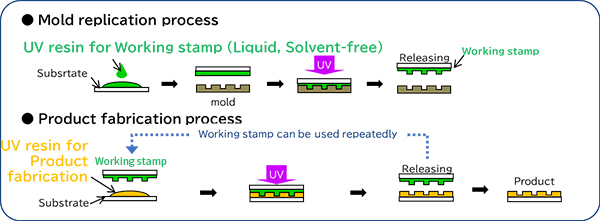Working stamp resin PAK-TRAD series
what is Working stamp
The resin for the Working stamp has already used for products such as XR/MR/AR devices, optical elements. Its quality characteristics, such as excellent durability in repeated transfers and high mold release properties that eliminate the need for release agents, make it particularly useful for optical applications where advanced molding precision is required. It has been confirmed to have good compatibility with a wide range of optical resins and is available as the "PAK-TRAD Series*1."
*1 PAK-TRAD Series is products under development.
- Examples of fabrication

- Comparison of durability


Features
Previously, expensive master molds were used repeatedly. In this technology, the shape of the master mold is replicated using resin for the working stamp(PAK-TRAD series) in the master mold replication process. In the product fabrication process, you can obtain finely processed products at the nano-scale by repeatedly using the working stamp. Additionally, it can be conveniently manufactured using conventional UV nanoimprint technology without the need for new technology adoption. In our lineup of UV nanoimprint resins, we offer the "PAK-TRAD series" resin specifically designed for the working stamp.

Introduction of PAK-TRAD series
Main features
- High durability for repeat imprinting
- High releasing property
- Solvent-free, no pre-bake process for solvent removal
- UV cure only, no post-bake process to ensure curing

Properties of PAK-TRAD series
| Type and Main feature | PAK-TRAD03 High release property |
PAK-TRAD10 High sensitivity for UV curing |
||||||
|---|---|---|---|---|---|---|---|---|
| Curing method | UV | UV | ||||||
| Categories | ・Acrylic ・Radical polymerization |
・Acrylic ・Radical polymerization |
||||||
| Solvent-free | Yes | Yes | ||||||
| Before UV-curing (Liquid) |
Appearance | Clear | Clear | |||||
| Kinetic Viscosity (25 ˚C) | 32 cSt | 52 cSt | ||||||
| After UV-curing (Solid) |
Young's modulus (by nanoindentation) |
3 GPa | 2 Gpa | |||||
| Pencil hardness | F | B | ||||||
| Transmittance@365nm*2 | 83 % | 83 % | ||||||
| Conditions of UV-curing | Recommended light source | UV-LED(365 nm) High pressure mercury lamp Metal halide lamp |
UV-LED(365 nm) High pressure mercury lamp Metal halide lamp |
|||||
| Irradiance(365 nm) | 25-1,000mW/cm2 | 25-1,000 mW/cm2 | ||||||
| Exposure amount | >20 J/cm2 | >1.5 J/cm2 | ||||||
| Master mold |
Material | Metal(Ni, Si) *3, Quartz*3, Polymer | Metal(Ni, Si) *3, Quartz*3, Polymer | |||||
| Anti-sticking layer treatment | Fluorine-based silane coupling agent | Fluorine-based silane coupling agent | ||||||
| Pattern shape | Line/Space, Hole, Pilar, Grating etc | Line/Space, Hole, Pilar, Grating etc | ||||||
| Suitable substrates | Adhesion treated PET film (Toyobo's COSMOSHINE) or adhesion treated glass or Si |
Adhesion treated PET film (Toyobo's COSMOSHINE) or adhesion treated glass or Si |
||||||
| Application method | ・Spin coating 500rpm:10 μm 1,000rpm:5 μm ・Dispense ・Wire bar or applicator coating ・Slit coating |
・Spin coating 1,000rpm:11 μm 2,000rpm:6 μm ・Dispense ・Wire bar or applicator coating ・Slit coating |
||||||
| Recommended thickness | 5-20 μm | 5-20 μm | ||||||
| Storage | Dark cold place (preferably 0-25˚C) |
Dark cold place (preferably 0-25˚C) |
||||||
| Please note that these are not specification values. *2 Transmittance of UV-cured resin with a PET film. (Resin thickness: approx.10 μm, Film thickness: 100 μm, Transmittance of a PET film: 84%). *3 We recommend to treat with release agent in advance. |
||||||||



